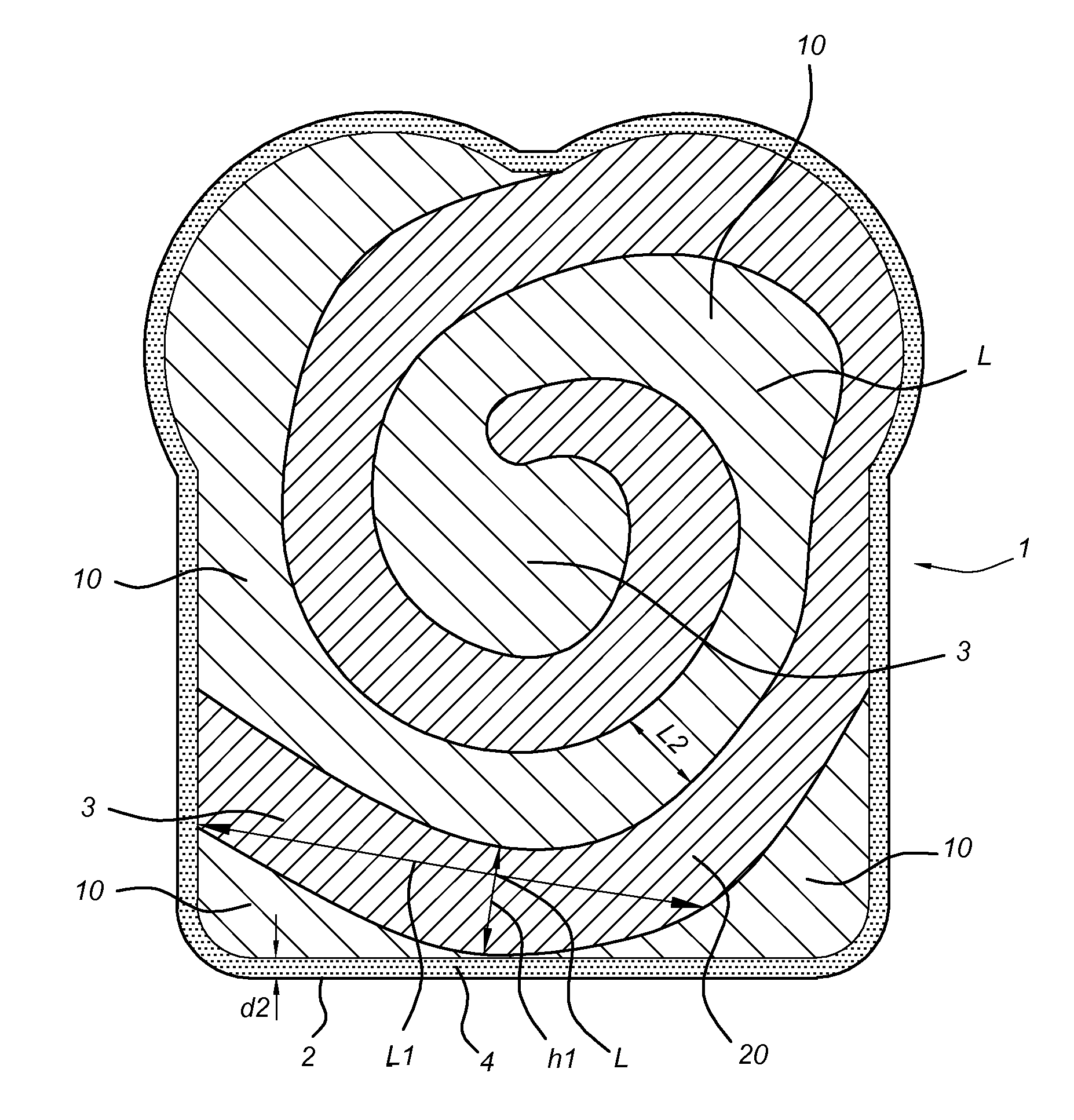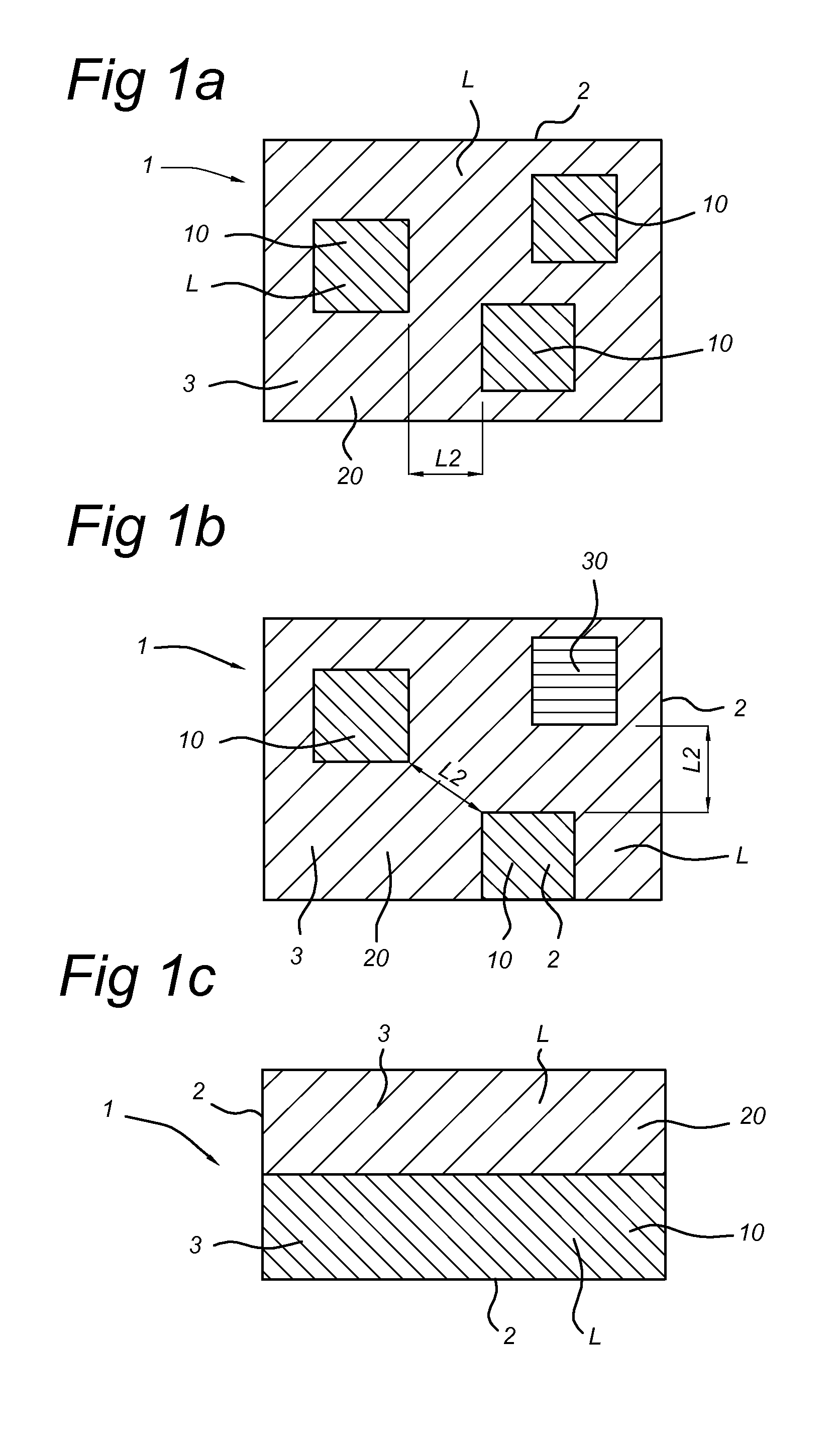Flour-based food product with inhomogeneous tastant bulk distribution and method for making such food product
a technology bulk distribution, which is applied in the field of flour-based food products, can solve the problems of not providing a method, or providing a suitable method, and prior art does not provide or indicate a suitable method for providing an uneven distribution of food components, so as to improve the sensory perception of tastant and reduce the percentage of tastant bulk weigh
- Summary
- Abstract
- Description
- Claims
- Application Information
AI Technical Summary
Benefits of technology
Problems solved by technology
Method used
Image
Examples
example 1
Salt Perception in Bread
Experimental Set Up
[0222]Three bread samples were made with about 1.5 wt % salt on flour (basis), but varying in salt distribution:[0223]C) reference bread with a homogeneous salt distribution with 1.0 cm layer thickness of dough with medium / medium salt content (1.5 wt. % and 1.5 wt. %);[0224]B) inhomogeneous bread with 0.5 cm layer thickness of dough with high / low salt content (2.75 wt. % and 0.25 wt. %);[0225]A) inhomogeneous bread with 1.0 cm layer thickness of dough with high / low salt content (2.75 wt. % and 0.25 wt. %).
Preparation of Bread Samples
[0226]A lean bread recipe was used, composed of Edelweiss flour, tap water, kitchen salt (NaCl) and Fermipan red instant yeast (see table 1.1). Doughs were mixed using Hobart mixers. In this way it was possible to produce multiple doughs with varying salt content at the same time. The 3 bread variations could thus be baked at the same time, allowing comparable sensory testing. Bread with a homogeneous salt distr...
example 2
Salt Perception in Bread
Experimental Set Up
[0240]A bread with an inhomogeneous salt distribution was prepared by placing three layers of dough on top of each other into a tin. The salt concentrations within the layers were 0.5% (bottom layer), 3% (middle layer) and 1% (top layer) resulting in an average salt concentration of 1.5% in the final product. The saltiness perception and morphology of the bread with an inhomogeneous salt distribution (1.5% salt) was compared with a bread with a homogeneous salt distribution (2% salt).
[0241]Dough recipes are given in the table 2.1 below. The doughs were prepared using a spiral mixer for 2+6 minutes at 26° C., followed by 5 minutes rest. Doughs were transferred to the tins (600 g per tin). For preparation of the inhomogeneous bread, dough sheets of 2 cm thickness were cut according to tin size. 3 layers of dough were placed on top of each other into the tin; from the bottom up into the tin: 0.5%-3%-1%. Doughs were fermented for 45 minutes at ...
example 3
Salt Perception in Bread
[0245]A group of consumers tasted bread samples to evaluate whether an inhomogeneous distribution of salt in bread enhances saltiness perception.
Samples
[0246]Bread samples were prepared as follows:
[0247]A lean bread recipe was used, as shown in table 3.1. Salt reduces the yeast activity. Therefore, the amount of yeast in each dough was compensated to obtain a constant fermentation speed in each dough, independent from the salt concentration.
[0248]Dough was mixed using Hobart mixers. After pre-fermentation dough with high and low NaCl content was sheeted through a gap size of 2.5 mm. Four of these dough sheets were stacked with alternating high and low salt content. This dough was cut in two parts, which were again stacked. In this way a sheet of dough consisting of 8 layers of dough with alternating high and low NaCl content was created. From this sheet, rectangular shaped dough pieces of 909 grams were made and put in bread tins.
[0249]After a final proofing ...
PUM
 Login to View More
Login to View More Abstract
Description
Claims
Application Information
 Login to View More
Login to View More - R&D
- Intellectual Property
- Life Sciences
- Materials
- Tech Scout
- Unparalleled Data Quality
- Higher Quality Content
- 60% Fewer Hallucinations
Browse by: Latest US Patents, China's latest patents, Technical Efficacy Thesaurus, Application Domain, Technology Topic, Popular Technical Reports.
© 2025 PatSnap. All rights reserved.Legal|Privacy policy|Modern Slavery Act Transparency Statement|Sitemap|About US| Contact US: help@patsnap.com



